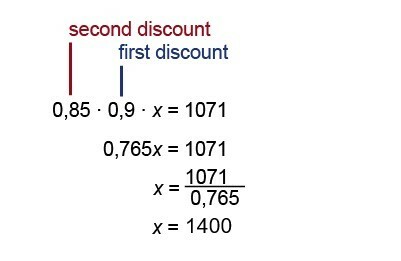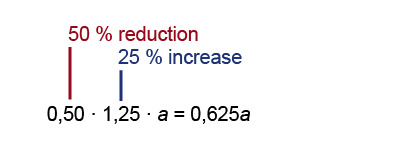9. Unknown base value
Unknown base value
In percentage calculations, you must always be precise about the base value to which the percentage changes are applied. However, in some cases, the base value is not known. When this is the case, the unknown base value is denoted by a letter, and the calculations are otherwise performed in the usual way.
Example 1
Of what number is the number [[$ 37 $]] [[$ 20 \: \% $]]?
Let us denote the base value with the letter [[$ a $]] and form an equation:
[[$ 0,2 \cdot a = 37 $]] || : [[$ 0,2 $]]
[[$ a = \displaystyle\frac {37} {0,2} $]]
[[$ a = 185 $]]
Example 2
Melanie has [[$ 15 \: \% $]] of her money in her wallet and keeps the rest in her bank account. She has [[$ 105 $]] QAR in her wallet. How much money does Melanie have in her bank account?
Solution:
The percentage factor is [[$ 0,15 $]] and the value of this percentage is [[$ 105 $]] QAR. Before calculating the money in Melanie’s account, you have to calculate how much money she has in total. In other words, you have to calculate the base value [[$ a $]].
[[$ 0,15 \cdot a = 105 \: \text {QAR} $]] || [[$ : 0,15 $]]
[[$ a = \displaystyle\frac {105 \: \text{ QAR}} {0,15} $]]
[[$ a = 700 \text{ QAR} $]]
Melanie has [[$ 100 \: \% - 15 \: \% = 85 \: \% $]] of all her money in her bank account.
[[$ 0,85 \cdot 700 \: \text{ QAR} = 595 \: \text{ QAR} $]]
Answer: Melanie has [[$ 595 $]] QAR in her account.
Example 3
The price of the computer was first reduced by [[$ 10 \: \% $]] and later by a further [[$ 15 \: \% $]]. After the discount, the computer cost [[$ 1071 $]] QAR. How much did the computer originally cost?
Solution:
Let's form an equation where the letter [[$ x $]] denotes the original price of the computer.
The price that is [[$ 10 \: \% $]] cheaper than the original is obtained by multiplying the original price by [[$ 0,9 $]]. The additional [[$ 15 \: \% $]] discount is taken into account by multiplying the previous price by [[$ 0,85 $]].

Answer: The price of the computer before the discount was [[$ 1400 $]] QAR.
Example 4
[[$ 25 \: \% $]] of a number is first added to the same number, after which [[$ 50 \: \% $]] of the number is subtracted from the result. What percentage is the result from the original number?
Solution:
The base value, i.e. the original number, is now unknown, so it is denoted by the letter [[$ a $]].
The [[$ 25 \: \% $]] increase is applied by multiplying the base value by [[$ 1,25 $]] and the additional [[$ 50 \: \% $]] reduction is taken into account by multiplying the changed base value by [[$ 0,50 $]].

Finally, calculate what percentage of this is from the original number:
[[$ \displaystyle\frac {0,625 \: a} { \: a} = 0,625 = 62,5 \: \% $]].
Answer: The result is [[$ 62,5 \: \% $]] of the original number.